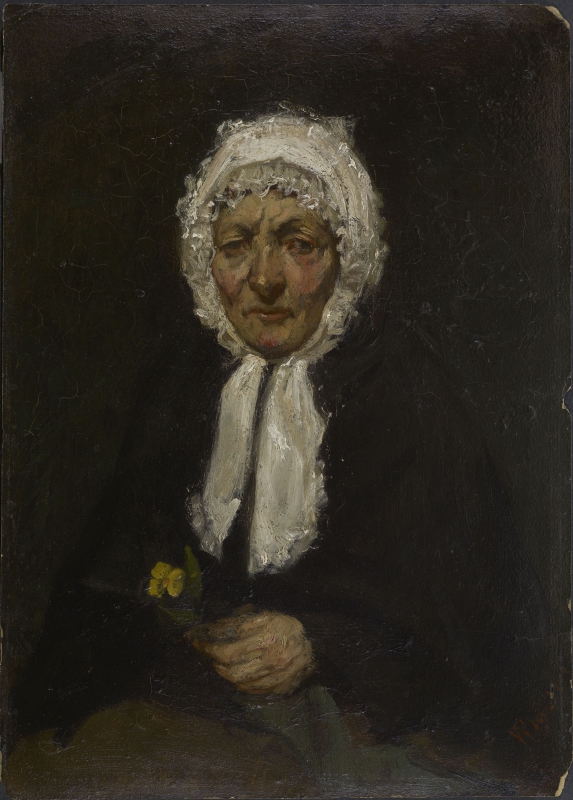Home > Catalogue > Browse > La Mère Gérard (1) << >>
Provenance
- 1860s: given by Whistler to Algernon Charles Swinburne (1837-1909), London;
- 1909: bequeathed to Walter Theodore Watts-Dunton (1832-1914), London;
- 1912: according to a later owner, Alfred Edward Newton (1864-1940), sold by Watts-Dunton to the publisher William Heinemann (1863-1920), London, for £150;
- 1920-1922: after Heinemann's death, 5 October 1920, sold at auction, American Art Association, New York, 13 January 1922 (lot 214), and bought by Alfred Edward Newton (1864-1940) of Philadelphia, Pa., for $1800;
- 1940: bequeathed to his son, Edward Swift Newton (1894-1976);
- 1968: sold at auction, Sotheby's, London, 1 May 1968 (lot 14), and bought by Bernard C. Solomon (n/a), Los Angeles.
- 2013: given by Peter H. Lunder (b. 1933) and Paula Crane Lunder (b. 1935) to Colby College Museum of Art.
According to the Pennells, Whistler had intended to give the portrait to the sitter, but then he considered it too good for her and gave her a copy (see La Mère Gérard (2) [YMSM 027]); she 'saw the difference and was furious'. 1
It was given by Whistler to his friend, the poet Algernon Charles Swinburne. 2 It may have been in 1878 that Whistler asked Swinburne, 'do you think I might on Monday send for the Mère Gérard?'; it is possible that he thought of presenting it as a work exhibited at the Royal Academy, during the Whistler v. Ruskin trial of 1878, and indeed it was listed in the curriculum vitae prepared by Whistler's attorney for the trial. 3
In 1888 Whistler regretfully repudiated his friendship with Swinburne and later regretted his generosity: in 1892 he told the art dealer Edward Guthrie Kennedy (1849-1932), 'The Mère Gérard, was the other instance of folly I cited - the present I made to Swinburne.' 4 In 1900 he expressed to the Pennells his desire to repossess the portrait: 'I must have [it] back from Swinburne. Time has changed the conditions of the gift, and therefore of course, as will be understood among gentlemen, the gift must be returned.' 5 However, it was not returned.
Exhibitions
- 1859: Atelier of François Bonvin, Paris, 1859.
- 1861: 93rd Exhibition of the Royal Academy of Arts, London, 1861 (cat. no. 272) as 'La Mère Gérard'.
- 1905: Memorial Exhibition of the Works of the late James McNeill Whistler, First President of The International Society of Sculptors, Painters and Gravers, New Gallery, Regent Street, London, 1905 (cat. no. 68) as 'La Mère Gérard'.
1859: According to Thomas Armstrong (1832-1911), this portrait was praised by Jean-Désiré-Gustave Courbet (1819-1877) when he saw it in the studio of the artist, François Bonvin (1817-1887), 189 rue St-Jacques, Paris, in May 1859. 6
1861: When it was exhibited by Whistler in London, at the Royal Academy, the portrait received mixed reviews. Several commented on the powerful painterly qualities but disliked the dark palette. The Times described it as 'A small, dark, dirty head' but added that, 'Small as it is, this head shows some of the rarest and truest pictorial gifts.' 7 The Athenaeum praised the painting as 'a fine, powerful-toned, and eminently characteristic study of an old woman's head … This little work, which is badly placed, contains some admirable qualities of real Art of the best executive order.' 8
The Daily Telegraph had stronger reservations, commenting that the painting would be better placed 'over the stove in the studio than to be exhibited at the R.A.,' but was nevertheless 'replete with evidence of genius and study'. The condemnation continued,
'If Mr Whistler would leave off using mud and clay on his palette, and paint cleanly, like a gentleman, we should be happy to bestow any amount of praise on him for he has all the elements of a great artist in his composition. But we must protest against his soiled and miry ways.' 9
The critic for The Saturday Review also remained underwhelmed: 'Mr Whistler has copied an old woman's face in most naturalistic style in his "La Mere Gerard" (272). He shows he could do more, if he chose.' 10 On a similar note, The Sunday Times remarked, 'J. Whistler's "La Mere Gerard" has certain power in it, but in a subject so small one likes to see finish also.' 11
1905: Over forty years later, by the time of the Whistler Memorial exhibition in London, journalist's views had changed. The Daily Telegraph & Courier on 13 March 1905 saw in it the influence of Rembrandt Harmens van Rijn (1617-1681): 'In the first exhibited picture, "La Mère Gérard" there is already consummate art of its kind, and the American artist proves what he can accomplish under the direct influence of Rembrandt.'
Notes:
1: Pennell 1908 [more], vol. 1, pp. 57, 68.
2: Whistler to E. G. Kennedy, 10-11 June 1892, GUW #09680.
3: [July 1876/July 1878], GUW #09443. See also J. A. Rose, list, [25-26 November 1878], GUW #11914, and Whistler to Rose [November 1878], GUW #08784.
4: 10-11 June 1892, GUW #09680.
5: Quoted in Pennell 1921C [more], p. 80.
6: Lamont 1912 [more], pp. 179, 186, 190.
7: Anon., 'Exhibition of the Royal Academy', The Times, London, 4 May 1861, p. 12.
8: Anon., 'Fine Arts: Royal Academy', The Athenaeum, no. 1752, 25 May 1861, pp. 698-700, at p. 698.
9: Anon., 'R. A. Exhibition, 2nd Notice', The Daily Telegraph, London, 6 May 1861, p. 5, quoted in Goebel 1988 [more], p. 693.
10: Anon., ‘The Royal Academy Exhibition (II)’, The Saturday Review, vol. 19, 25 May 1861, pp. 531-32.
11: Anon., 'Notes on Arts by Artismator: R.A. Exhibition: 4th Notice', Sunday Times, London, 2 June 1861, p. 2.
Last updated: 18th April 2021 by Margaret





